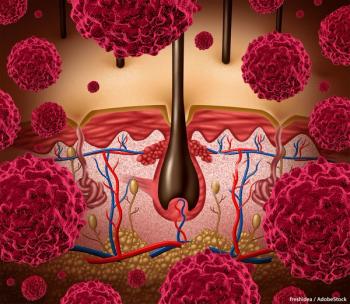
Oncology NEWS International
- Oncology NEWS International Vol 9 No 3
- Volume 9
- Issue 3
Temozolomide Equal to DTIC in Melanoma
MANCHESTER, UK-Oral temo-zolomide (Temodar) is as effective as intravenous dacarbazine (DTIC) in advanced metastatic malignant melanoma and is a reasonable alternative for many patients, according to a phase III trial. Temozolomide
MANCHESTER, UKOral temo-zolomide (Temodar) is as effective as intravenous dacarbazine (DTIC) in advanced metastatic malignant melanoma and is a reasonable alternative for many patients, according to a phase III trial. Temozolomide (TMZ) can be given as outpatient treatment and was superior to DTIC at maintaining or improving physical function, fatigue, and insomnia.
The agent is FDA approved in the United States for use in treating adult patients with anaplastic astrocytoma who have relapsed after chemotherapy including a nitrosourea and procarbazine.
An Important Role
Lead investigator Mark R. Middleton, MD, said that the improvements in overall survival, progression-free survival, and some quality-of-life (QOL) domains, along with the acceptable safety profile and ability to penetrate the central nervous system (CNS), suggest that TMZ could play an important role in the future management of this disease.
Dr. Middleton is in the Department of Medical Oncology at Christie Hospital, Manchester, United Kingdom.
This is an oral alternative to DTIC that requires further evaluation with regard to schedule and combination with other agents, and in specific indications such as intracerebral disease, Dr. Middleton told ONI in an interview.
Treatment of advanced metastatic melanoma remains palliative. Median survival time is about 6 months for patients with stage IV disease. Estimated 5-year survival is 6%.
Dr. Middleton and his colleagues decided to compare TMZ to a standard regimen of DTIC in a randomized, double-blind, phase III trial in an attempt to increase overall survival and to improve treatment tolerability and ease of administration. The study was powered to detect a 3-month (50%) difference in median survival time between treatments.
Temozolomide and DTIC are both prodrugs of the alkylating agent 5-(3-dimethyl-1-triazenyl)imidazole-4-car-boximide (MTIC). Temozolomide was chosen for this comparison because it has 100% oral bioavailability and wide tissue distribution, including crossing the blood-brain barrier and entering the cerebrospinal fluid.
The researchers enrolled 305 patients with advanced metastatic melanoma, 287 of whom were randomized to receive either oral TMZ (200 mg/m²/d × 5 days every 28 days) or intravenous DTIC (250 mg/m²/d × 5 days every 21 days). Patients with previous treatment for metastatic disease other than radiation were not eligible for the study, and patients with CNS metastases were excluded.
Treatment was continued for up to 12 cycles unless there was disease progression or intolerable toxicity. The effects of treatment were assessed with clinical and radiologic examination and with the European Organization for Research and Treatment of Cancer (EORTC) quality-of-life questionnaire (QLQ-C30). The researchers also measured plasma concentrations of TMZ, DTIC, and MTIC.
Intention-to-treat analysis showed median overall survival times of 7.7 months with TMZ vs 6.4 months with DTIC (P = .20; hazards ratio, 1.18; 95% confidence interval, 0.92 to 1.52) (J Clin Oncol 18:158-166, 2000).
Median progression-free survival was significantly better with TMZ (1.9 vs 1.5 months) (P = .012; hazards ratio, 1.37), but Dr. Middleton said that this difference probably occurred because patients treated with DTIC were examined for progression 2 weeks earlier than those treated with TMZ.
Trying to Find a Better Treatment
We were trying to find a better treatment for melanoma than DTIC. That TMZ is more tolerable with the same efficacy is of benefit, but falls short of what we had hoped to discover, Dr. Middleton said in an interview with ONI.
He continued, I dont think one can claim that TMZ might be more effective on the basis of improved disease-free survival, as this is largely an artifact of the protocol for disease reassessment in the two treatment groups. That TMZ may be more effective is possible, but our study was only powered to detect a 50% improvement in overall survival. A larger study (requiring 600 to 1,000 patients) would be needed to detect a smaller improvement, but such a study will never be done.
Complete response rates and overall response rates were similar for the two groups.
Both treatments were fairly well tolerated, with most adverse events being mild to moderate in severity. Myelosuppres-sion was not cumulative and resolved within 9 days. Grade 3-4 thrombocytopenia occurred in 11% of TMZ cycles and 7% of DTIC cycles. Grade 3-4 neutropenia occurred in 11% of TMZ cycles and 13% of DTIC cycles.
The most common adverse events in the patients receiving TMZ were nausea (52% of patients), vomiting (34%), pain (34%), and constipation (30%). The most common adverse events with DTIC were pain (39%), nausea (38%), constipation (29%), and vomiting (24%). Only 3% of TMZ patients and 5% of DTIC patients discontinued treatment due to toxicity, however.
Quality of Life Results
Patients completed questionnaires at 12 weeks after the beginning of treatment to assess effects on health-related QOL. At 12 weeks, statistically significant differences favoring the temo-zolomide-treated group were observed for physical functioning, fatigue, and insomnia. No significant differences were observed for the remaining QLQ-C30 scores, Dr. Middleton said.
When only responders were considered, the TMZ patients reported better physical functioning and less insomnia, and there was a significant advantage in the physical and cognitive functioning domains for the temozolomide-treated group, compared with the DTIC-treated group, he said.
Pharmacokinetic analysis showed that although intravenous DTIC was given at a higher dose, systemic exposure to the active intermediate MTIC was twice as high in patients treated with oral temozolomide.
According to Dr. Middleton, mean systemic exposure to MTIC is so much higher with oral temozolomide because DTIC must go through a metabolic transformation to active MTIC, while temo-zolomide spontaneously converts to MTIC under physiologic conditions. I was surprised that there was so much difference in the MTIC exposure between the two agents, he said.
In conclusion, Dr. Middleton said that the study confirmed phase II trial data showing that temozolomide is at least as effective against advanced metastatic melanoma as DTIC. Although the trend in overall survival favored temozolomide, the difference did not reach the 50% increase required for statistical significance in a sample this size.
Articles in this issue
almost 26 years ago
IL-13 Used to Deliver Bacterial Toxin to Brain Tumors in Micealmost 26 years ago
Rituximab/CHOP Combo Effective in Low-Grade NHLalmost 26 years ago
3D CT-Guided Seminal Vesicle Biopsy for Stagingalmost 26 years ago
Elderly Patients Tolerate Breast Cancer Therapyalmost 26 years ago
Coaxial Breast Biopsy Device Provides Diagnostic Specimensalmost 26 years ago
3D Digital Camera Accurately Calculates Breast Shape, Volumealmost 26 years ago
Thermoacoustic CT Under Development for Breast Imagingalmost 26 years ago
Early Local Recurrence After Lumpectomy Predicts Metastasisalmost 26 years ago
Panel Recommends Listing 9 Substances in Carcinogen ReportNewsletter
Stay up to date on recent advances in the multidisciplinary approach to cancer.



















































































